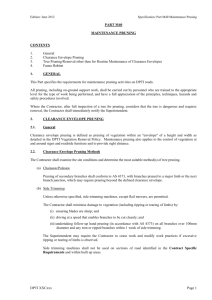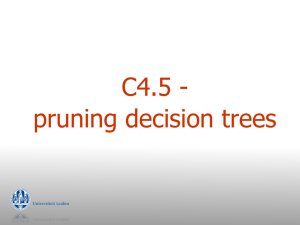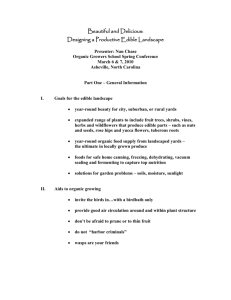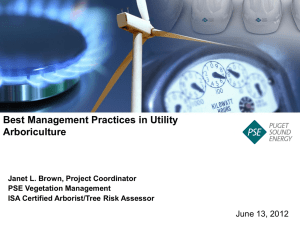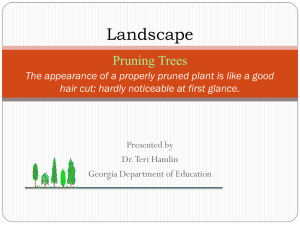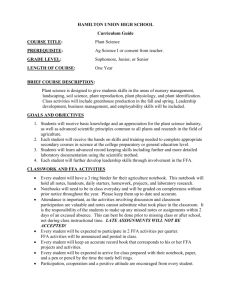Part L40 Tree Pruning and Removal
advertisement
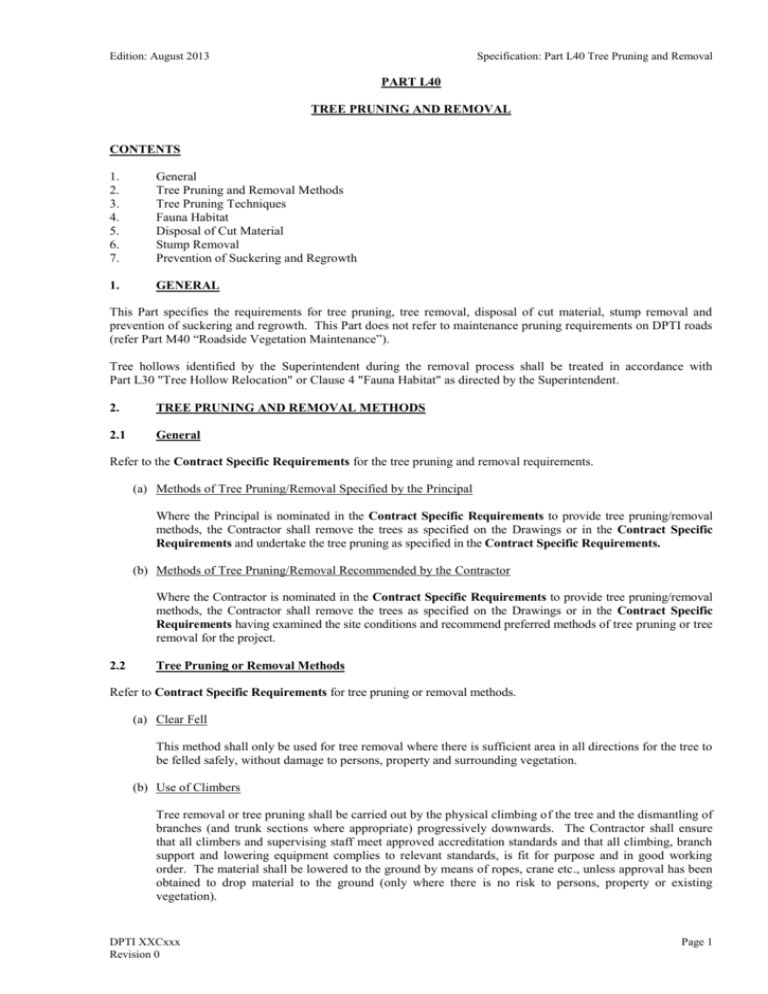
Edition: August 2013 Specification: Part L40 Tree Pruning and Removal PART L40 TREE PRUNING AND REMOVAL CONTENTS 1. 2. 3. 4. 5. 6. 7. General Tree Pruning and Removal Methods Tree Pruning Techniques Fauna Habitat Disposal of Cut Material Stump Removal Prevention of Suckering and Regrowth 1. GENERAL This Part specifies the requirements for tree pruning, tree removal, disposal of cut material, stump removal and prevention of suckering and regrowth. This Part does not refer to maintenance pruning requirements on DPTI roads (refer Part M40 “Roadside Vegetation Maintenance”). Tree hollows identified by the Superintendent during the removal process shall be treated in accordance with Part L30 "Tree Hollow Relocation" or Clause 4 "Fauna Habitat" as directed by the Superintendent. 2. TREE PRUNING AND REMOVAL METHODS 2.1 General Refer to the Contract Specific Requirements for the tree pruning and removal requirements. (a) Methods of Tree Pruning/Removal Specified by the Principal Where the Principal is nominated in the Contract Specific Requirements to provide tree pruning/removal methods, the Contractor shall remove the trees as specified on the Drawings or in the Contract Specific Requirements and undertake the tree pruning as specified in the Contract Specific Requirements. (b) Methods of Tree Pruning/Removal Recommended by the Contractor Where the Contractor is nominated in the Contract Specific Requirements to provide tree pruning/removal methods, the Contractor shall remove the trees as specified on the Drawings or in the Contract Specific Requirements having examined the site conditions and recommend preferred methods of tree pruning or tree removal for the project. 2.2 Tree Pruning or Removal Methods Refer to Contract Specific Requirements for tree pruning or removal methods. (a) Clear Fell This method shall only be used for tree removal where there is sufficient area in all directions for the tree to be felled safely, without damage to persons, property and surrounding vegetation. (b) Use of Climbers Tree removal or tree pruning shall be carried out by the physical climbing of the tree and the dismantling of branches (and trunk sections where appropriate) progressively downwards. The Contractor shall ensure that all climbers and supervising staff meet approved accreditation standards and that all climbing, branch support and lowering equipment complies to relevant standards, is fit for purpose and in good working order. The material shall be lowered to the ground by means of ropes, crane etc., unless approval has been obtained to drop material to the ground (only where there is no risk to persons, property or existing vegetation). DPTI XXCxxx Revision 0 Page 1 Edition: August 2013 Specification: Part L40 Tree Pruning and Removal (c) Elevated Platform This method shall be used where machinery access is available, with one or two operators in a basket traveling up in the crown to remove branches. The Contractor shall ensure operating staff have received approved training in use of this equipment. The material shall be lowered to the ground by means of ropes, crane etc., unless approval has been obtained to drop material to the ground (only where there is no risk to persons, property or existing vegetation). (d) Other 3. TREE PRUNING TECHNIQUES 3.1 General Prior to pruning, the Contractor shall assess the tree’s health, growth habit, structure, stability and pruning requirements. Equipment that wounds the bark or conductive tissues (i.e. spurs, spikes, hooks) shall not be used on sections of the tree to be retained. All cutting tools shall be sharp and branches shall be undercut to prevent splitting or tearing of the branch collar or trunk. All pruning, including on-ground support work, shall be carried out by personnel who are trained to the appropriate level for the type of work being performed, and have a full appreciation of the principles, techniques, hazards and safety procedures involved. All pruning shall conform to AS 4373 "Pruning of Amenity Trees" unless otherwise specified in the Contract Specific Requirements. The pruning procedures and types described in this standard shall also form the basis for pruning indigenous vegetation in rural and remote areas. Whenever the Contractor, after full inspection of a tree for pruning, considers that the tree is dangerous and requires removal, the Contractor shall immediately notify the Superintendent. 3.2 Tree Pruning (a) Thinning Thinning of the crown shall be undertaken by removing secondary branches whilst retaining the main structural branches of the tree. This may include selective thinning to lessen wind resistance, to reduce the weight of limbs, to increase light penetration and air movement through the crown or to restore views. (b) Deadwooding Deadwood shall be removed from the tree. (c) Selective Pruning Branches identified as causing a specific problem (e.g. conflicting branches) shall be removed. (d) Formative Pruning of Young Trees The Contractor shall selectively remove specific branches to enhance form and improve structure, and to directionally shape the young tree. With smaller diameter branches it may be necessary to reduce the branch to a dormant bud. Formative pruning shall aim to reduce the development of structural weaknesses and to accommodate site constraints and reduce encroachment on utilities or buildings as the tree grows. (e) Reduction Pruning The Contractor shall reduce the size of the crown of the tree either in the height or spread. The ends of the branches shall be removed to internal lateral branches or stems. (f) Crown Lifting Lower branches shall be removed to the clearance height specified. DPTI XXCxxx Revision 0 Page 2 Edition: August 2013 Specification: Part L40 Tree Pruning and Removal (g) Pollarding Trees shall be cut back to just above the existing pollard. When removing shoots, pollard heads should not be injured. Cuts should be made as close as possible to the swollen collars that surround each shoot. This pruning process is suited mostly to deciduous trees that have been formatively pruned at an early age and should not be carried out on mature trees that have not been previously pollarded. (h) Remedial Pruning The Contractor shall undertake remedial pruning to remove damaged, diseased or lopped branches back to undamaged branches back to undamaged or healthy tissue. This type of pruning should only be carried out on trees which have lost their natural form and structure through storm damage, lopping, dieback or disease. 3.4 Control of Bees and Wasp The Contractor shall be responsible for the control of bees and wasps in trees to be pruned or removed. 4. FAUNA HABITAT 4.1 General The removal of trees, particularly in rural and remote areas, often results in the removal of hollows. These hollows have important habitat values for indigenous fauna species. Where hollows are encountered during the tree removal process, or where directed by the Superintendent, the following shall apply. Every effort shall be made to avoid the disturbance of native fauna occupying the tree and/or tree hollows. In the event of the discovery of fauna requiring relocation the Superintendent shall be notified immediately. Where material suitable for habitat creation is encountered during the pruning, it shall be prepared in accordance with Contract Specific Requirements. The Contractor shall dispose of all cut material resulting from the activities described in Clause 3.2 (a), (b) and (c) in accordance with Clause 5 “Disposal of Cut Material”. 4.2 Retention of Cut Material Refer to Contract Specific Requirements for retention of cut material methods. (a) Retention of Cut Branches or Limbs As directed by the Superintendent, all or selected cut branches or limbs shall be positioned on the ground within the site. (b) Retention of Tree Hollows for Terrestrial Relocation All cut material containing hollows greater than 50 mm in diameter shall be stockpiled on site and relocated in accordance with Part L30 Contract Specific Requirements. (c) Retention of Tree Hollows for Arboreal Relocation All cut material containing hollow apertures greater than 40% of the trunk diameter shall be stockpiled onsite and relocated in accordance with Part L30 Contract Specific Requirements. 5. DISPOSAL OF CUT MATERIAL 5.1 General The removal operation shall be carried out in a manner involving minimal movements across the site resulting in minimal disturbance to the vegetation, soil and watercourses. DPTI XXCxxx Revision 0 Page 3 Edition: August 2013 Specification: Part L40 Tree Pruning and Removal The Contractor may use an approved motorised chipping unit to process the upper canopy and minor branches of woody weeds. The unit shall be in good working order, shall comply with all applicable OHS&W, noise and spark arrestor requirements, and shall be operated only by trained operators equipped with appropriate personal safety equipment. 5.2 Disposal Methods Cut and chipped material shall be disposed of in accordance with the Contract Specific Requirements or Environmental Management Plan. This may require stockpiling on site, spreading over the worksite, removal from site or burning. All plant material containing proclaimed and environmental weed species shall be removed from the site and disposed at a licensed waste depot. Permits for transportation shall be obtained by the Contractor. Refer to the Contract Specific Requirements for the disposal methods. (a) Stockpile On-Site Chipped prunings shall be stockpiled on site in the location shown on the Drawing or as agreed with the Superintendent. (b) Spread On-Site Where approved by the Superintendent, chipped prunings may be left on site where they provide protection to exposed soil, will not inhibit regeneration of indigenous species, will not significantly increase the current fuel load at the site. Chipped prunings may be spread evenly over the ground taking care to avoid indigenous grasses and ground covers. The spread chippings are not to exceed 100 mm in depth across the site. (c) Remove From Site The Contractor shall remove all material from site. (d) Burning All material shall be burnt on site or at a suitable location proposed by the Contractor and approved by the Superintendent. The Contractor shall comply with all fire bans and restrictions, and shall obtain an appropriate permit to carry out burning. (e) Phytophthora (Dieback) Areas In High Risk Phytophthora (Dieback) areas, all cut material shall be disposed of at a licensed waste depot or burnt. 6. STUMP REMOVAL The Contractor shall remove the stumps to the extent shown on the Drawings or listed in the Contract Specific Requirements. Refer to Contract Specific Requirements for stump removal methods. (a) Grinding to full extent. (b) Grinding to 300 mm below the surface. (c) Cutting to ground level. (d) Cutting 100 mm above ground. Any excess sawdust and chippings shall be used to reinstate stump hole to natural ground level. DPTI XXCxxx Revision 0 Page 4 Edition: August 2013 7. Specification: Part L40 Tree Pruning and Removal PREVENTION OF SUCKERING AND REGROWTH Where a living tree is to be removed, a systemic herbicide shall immediately be applied to the main stem(s) at the manufacturer's recommended rate. Large stems (exceeding 20 mm diameter) shall be frilled to the depth of the sapwood below the main stem cut and immediately applied with herbicide to ensure adequate translocation of herbicide. All live stems shall be removed from the cut stump. Herbicide shall be applied immediately to all cut surfaces by brush (or similar), avoiding any spillage of herbicide on the soil or adjacent non-target plants. A red marking dye shall be added to the herbicide mix. This application shall allow sufficient time for the death of the tree stump prior to stump removal. ____________ DPTI XXCxxx Revision 0 Page 5 DPTI XXCxxx Revision 0 Page 6
